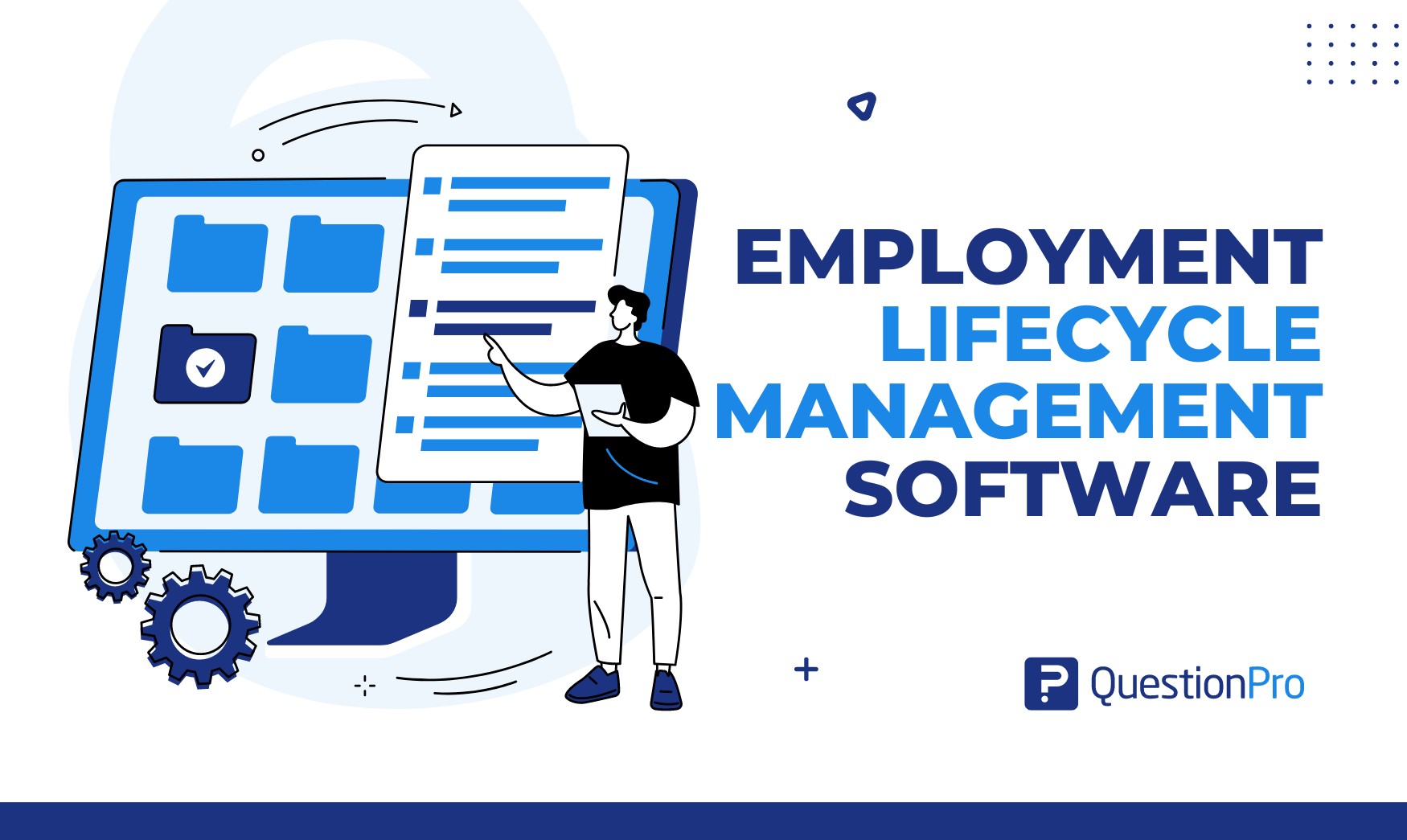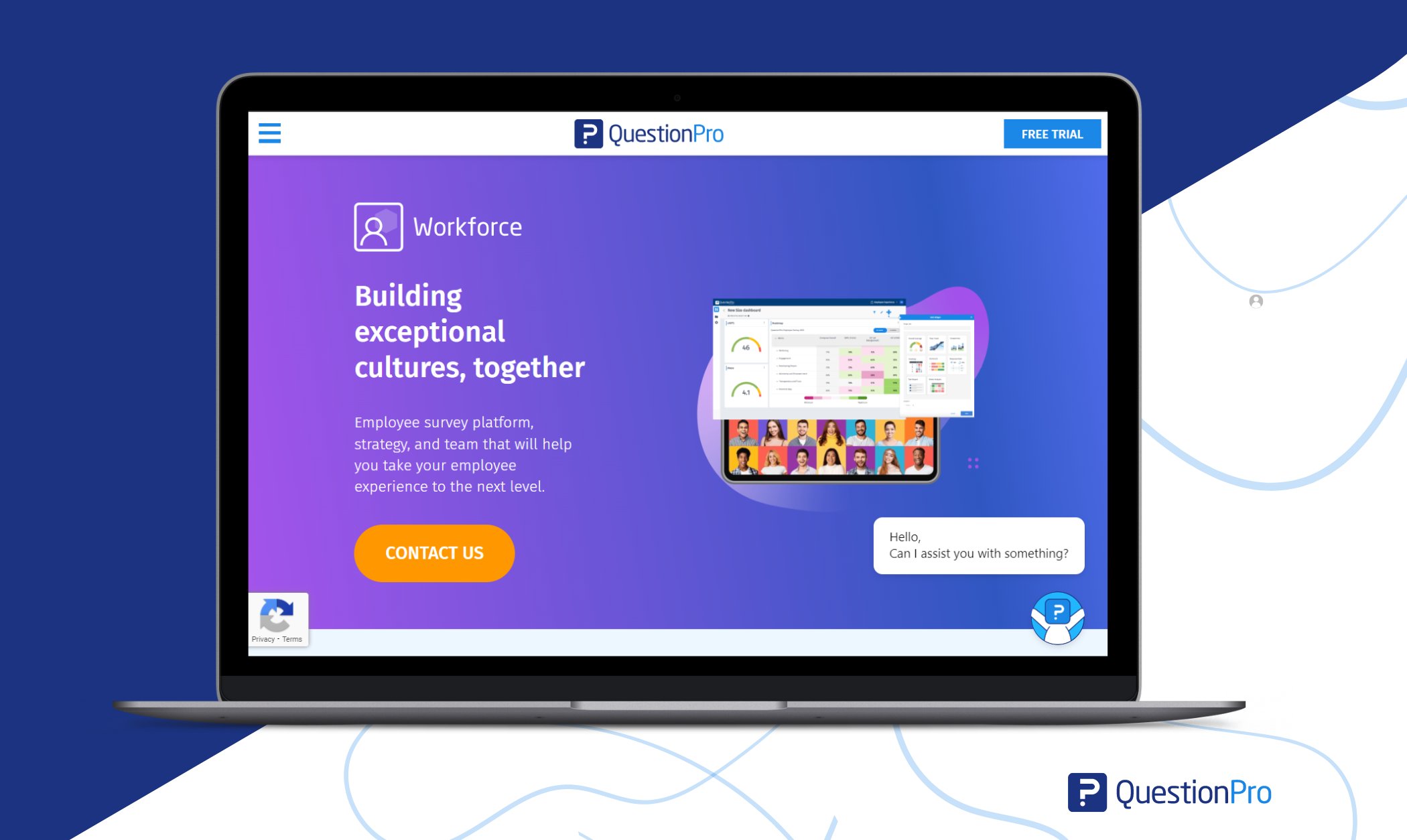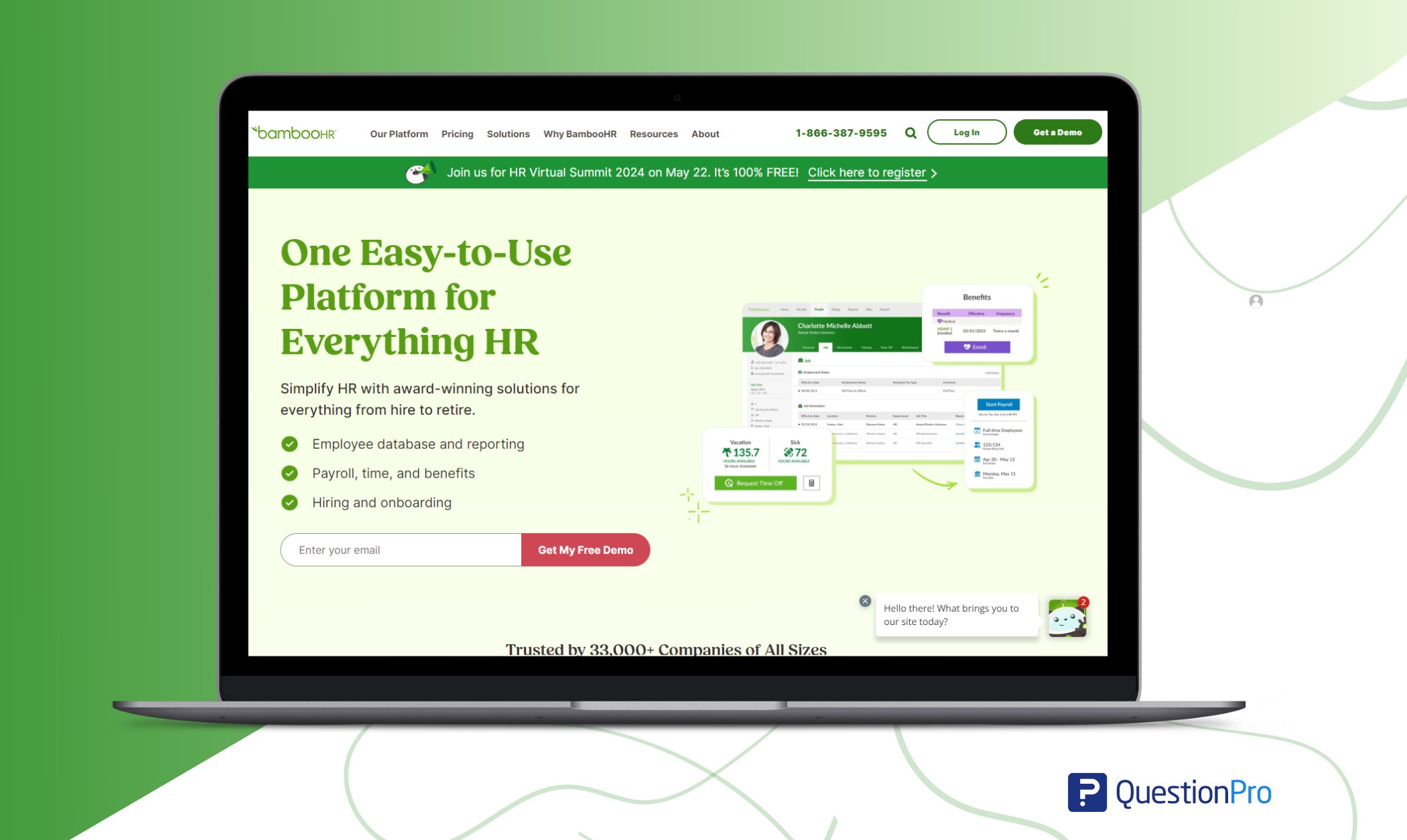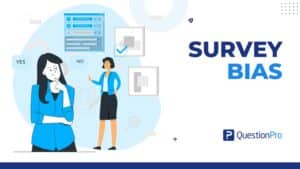
Managing human resources efficiently is paramount for organizational success. Employee Lifecycle Management Software has emerged as a cornerstone solution as companies strive to streamline operations and enhance productivity.
Employee Lifecycle Management Software streamlines and optimizes the entire employee life cycle, from recruitment to offboarding, ensuring seamless HR processes and maximizing employee satisfaction and productivity.
In this blog, we will introduce the concept of Employee Lifecycle Management, explore its functionalities, enumerate its benefits, and present the five best Employee Lifecycle Management software of 2026. Additionally, we’ll spotlight how QuestionPro Workforce optimizes the employee journey.
What is Employee Lifecycle Management Software?
Employee Lifecycle Management Software is an organization’s strategic approach to managing every stage of an employee’s journey, from recruitment to departure.
It encompasses various processes and activities that HR professionals and managers undertake to attract, onboard, develop, retain, and eventually separate employees systematically and effectively.
The employee lifecycle typically consists of several key stages:
- Recruitment: This stage involves attracting qualified candidates to fill job vacancies within the organization. It includes job posting, sourcing candidates, conducting interviews, and selecting the most suitable candidates.
- Onboarding: Once candidates are selected, the onboarding process begins. Onboarding involves welcoming new employees to the organization, providing them with necessary information and resources, introducing them to company policies and culture, and helping them integrate into their new roles and teams.
- Development: Employee development focuses on enhancing existing employees’ skills, knowledge, and capabilities to help them perform their current roles effectively and prepare for future career opportunities within the organization. It includes training programs, coaching, mentorship, and career development planning.
- Performance Management: Performance management involves setting expectations, providing feedback, evaluating employee performance, and recognizing and rewarding achievements. It aims to align individual performance with organizational goals and drive continuous improvement and development.
- Compensation and Benefits: This stage involves managing employee compensation and benefits, including salary, bonuses, incentives, health insurance, retirement plans, and other perks. It aims to ensure fair and competitive compensation packages that attract and retain top talent while aligning with the organization’s budget and objectives.
- Employee Engagement: Employee engagement focuses on creating a positive work environment where employees feel valued, motivated, and committed to their work and the organization. It involves fostering open communication, recognizing employee contributions, promoting work-life balance, and providing opportunities for growth and development.
- Offboarding: The offboarding stage occurs when an employee leaves the organization, either through resignation, retirement, or termination. It involves conducting exit interviews, handling administrative tasks such as finalizing paperwork and benefits, and facilitating a smooth transition for the departing employee and the remaining team members.
How Does Employee Lifecycle Management Software Work?
Employee Lifecycle Management software automates and streamlines the various employee lifecycle management processes. It leverages technology to centralize employee data, facilitate communication, and optimize HR workflows throughout an employee’s journey.
Here’s how employee lifecycle management software typically works:
1. Centralized Database
Employee lifecycle management software maintains a centralized database that stores comprehensive employee information, including personal details, employment history, performance evaluations, training records, compensation and benefits, and other relevant data. This database is a single source of truth for HR professionals to access and manage employee information efficiently.
2. Recruitment and Applicant Tracking
Employee lifecycle management software includes recruitment and applicant tracking modules, allowing HR teams to post job openings, receive and review job applications, schedule interviews, and communicate with candidates seamlessly. Advanced features such as resume parsing, candidate scoring, and interview scheduling streamline the recruitment process and help identify the most qualified candidates efficiently.
3. Onboarding and Orientation
Employee lifecycle management software facilitates onboarding by providing new employees access to essential resources, documents, and training materials. It may include electronic document signing, employee handbooks, compliance training modules, and task checklists to ensure a smooth transition for new hires.
4. Performance Management
Employee lifecycle management solution enables organizations to set performance goals, track progress, and evaluate employee performance. It may include goal setting, continuous feedback mechanisms, performance appraisal templates, and 360-degree feedback surveys to facilitate improved performance management processes and foster employee development.
5. Learning and Development
Employee lifecycle management software offers tools for managing employee training and development initiatives. It may include a learning management system (LMS) for delivering online courses, training modules, and certification programs. Additionally, it may track employee training progress, skill assessments, and competency profiles to support ongoing learning and development efforts.
6. Compensation and Benefits Administration
Employee lifecycle management software assists HR professionals in managing employee compensation and benefits programs. It may include modules for salary administration, bonus allocation, benefits enrollment, and payroll integration to ensure accurate and timely compensation processing while adhering to organizational policies and regulatory requirements.
7. Employee Engagement and Feedback
Employee lifecycle management software facilitates employee engagement initiatives by providing tools for conducting surveys, collecting feedback, and measuring employee satisfaction. It may include features such as employee pulse surveys, engagement analytics dashboards, and sentiment analysis to gauge employee sentiment and identify areas for improvement.
8. Offboarding and Exit Management
Employee lifecycle management software supports offboarding by guiding HR teams through the necessary steps when an employee leaves the organization. It may include exit interviews, offboarding checklists, asset return tracking, and automated notifications to ensure a seamless departure experience for departing employees and a smooth organizational transition.
9 Best Employee Lifecycle Management Software
1. QuestionPro Workforce
QuestionPro Workforce is a comprehensive platform designed to streamline employee lifecycle management, from recruitment to offboarding. It offers tools for recruitment, onboarding, performance management, learning and development, employee engagement, and more.

Key Features:
- Recruitment and applicant tracking.
- Onboarding and orientation.
- Performance management.
- Learning and development.
- Employee engagement surveys.
Pros:
- Comprehensive suite of HR tools.
- Intuitive interface.
- Customizable workflows.
Cons:
- Pricing may be higher for small businesses.
- Advanced features may require additional configuration.
Price: Essentials is Free. Advanced is $99 per user/per month. Team Edition is $83 per user/per month. More customized pricing is available upon request.
2. CultureMonkey
CultureMonkey is an employee engagement platform that measures and improves workplace culture. It offers tools for collecting employee feedback, assessing cultural alignment, and driving cultural change initiatives.
Key Features:
- Employee feedback surveys.
- Cultural alignment assessments.
- Action planning and follow-up.
Pros:
- Easy-to-use interface.
- Focus on employee engagement and culture.
Cons:
- Limited features compared to comprehensive ELM solutions.
- It may require integration with other HR tools for complete lifecycle management.
Price: Price is available upon request.
3. Qualtrics XM
Qualtrics XM is an experience management platform that includes employee management tools for employee experience management. It offers features for measuring employee engagement, conducting pulse surveys, and gathering feedback on various aspects of the employee lifecycle.
Key Features:
- Employee engagement surveys.
- Pulse surveys.
- 360-degree feedback.
Pros:
- Powerful analytics and reporting capabilities.
- Integration with other Qualtrics modules.
Cons:
- Higher pricing compared to some competitors.
- Steeper learning curve for advanced features.
Price: Price is available upon request.
4. Quantum Workplace
Quantum Workplace is an employee engagement software that helps organizations measure and improve employee engagement. It offers features for conducting surveys, analyzing feedback, and implementing action plans.
Key Features:
- Employee engagement surveys.
- Performance management tools.
- Recognition and rewards programs.
Pros:
- Easy-to-use interface.
- Actionable insights and recommendations.
Cons:
- Limited integrations with other HR systems.
- Pricing may be higher for smaller organizations.
Price: Price is available upon request.
5. Empuls
Empuls is an employee engagement platform that offers tools for recognizing and rewarding employees, promoting peer-to-peer recognition, and fostering a positive work culture.
Key Features:
- Recognition and rewards programs.
- Peer-to-peer recognition.
- Social recognition feed.
Pros:
- Focus on employee recognition and appreciation.
- Easy integration with existing HR systems.
Cons:
- Limited features for comprehensive lifecycle management.
- May require additional modules for full HR functionality.
Price: Surveys pricing starts from $3 per employee/month billed annually
6. Officevibe
Officevibe is an employee engagement platform that gathers feedback, measures employee satisfaction, and drives continuous improvement. It offers features for conducting surveys, analyzing feedback, and implementing action plans.
Key Features:
- Employee feedback surveys.
- Team health assessments.
- Action planning and follow-up.
Pros:
- Simple and intuitive interface.
- Actionable insights and recommendations.
Cons:
- Limited customization options.
- May lack some advanced features compared to competitors.
Price: Price starts from Essential US $3.50 /person/month
7. Connecteam
Connecteam is an all-in-one employee management app designed for deskless and remote workers. It offers features for communication, scheduling, task management, and more.
Key Features:
- Communication tools.
- Scheduling and shift management.
- Task tracking and completion.
Pros:
- Mobile-friendly interface.
- Suitable for deskless and remote workers.
Cons:
- May lack some advanced HR features.
- Pricing based on the number of users can be expensive for larger organizations.
Price: Operations Basic $35 /mo, For the first 30 users $0.6 / month for each additional user $29 /mo x 12 For the first 30 users $0.5 / month for each additional user
8. Lattice
Lattice is a performance management platform that helps organizations set goals, provide feedback, and develop employees. It offers features for performance reviews, goal setting, and 1-on-1 meetings.
Key Features:
- Performance reviews and evaluations.
- Goal setting and tracking.
- 1-on-1 meeting management.
Pros:
- User-friendly interface.
- Integration with other HR systems.
Cons:
- Focus primarily on performance management.
- Limited features are available for other stages of the employee lifecycle.
Price: Pricing is available upon request.
9. BambooHR
BambooHR is a cloud-based HR software solution designed for small and medium-sized businesses. It offers recruitment, onboarding, performance management, and HR administration features.

Key Features:
- Recruitment and applicant tracking.
- Onboarding and orientation.
- Performance management tools.
Pros:
- Easy-to-use interface.
- Affordable pricing for SMBs.
Cons:
- May need more advanced features compared to enterprise feedback solutions.
- Limited scalability for larger organizations.
Price: Pricing is available upon request.
The Benefits of Employee Lifecycle Management Software
The Benefits of Employee Lifecycle Management Software:
- Enhanced Efficiency: employee lifecycle management software automates repetitive tasks, reduces manual paperwork, and streamlines workflows, thereby increasing the efficiency of HR team processes.
- Improved Decision-Making: Employee lifecycle management software enables HR professionals to make informed decisions regarding recruitment, performance management, and talent development by providing access to real-time data and analytics.
- Enhanced Employee Experience: Employee lifecycle management software facilitates a seamless and personalized experience for employees from the moment they apply for a position to their eventual exit, leading to higher engagement and satisfaction levels.
- Compliance and Risk Management: Employee lifecycle management software helps ensure compliance with labor laws and regulations by centralizing employee data, facilitating audits, and enforcing standardized processes.
- Cost Savings: Employee lifecycle management software can significantly reduce organizations’ costs by reducing manual effort, minimizing administrative overhead, and optimizing workforce planning.
Learn More About Employee Pulse Survey Tools For Unlocking Business Insights
How QuestionPro Workforce Can Help in Managing Employee Lifecycle
QuestionPro Workforce is a comprehensive Employee Lifecycle Management software solution that streamlines HR processes and enhances employee engagement. Here’s how it helps manage the employee lifecycle:
- Recruitment and Onboarding: Simplifies recruitment with tools for job posting, applicant tracking, and candidate evaluation. Facilitates seamless onboarding by automating paperwork and delivering training materials.
- Performance Management: This service supports goal setting, feedback provision, and performance evaluations. It offers customizable templates and analytics dashboards to drive employee engagement and productivity.
- Learning and Development: Provides a learning management system (LMS) for delivering training courses, tracking progress, and assessing learning outcomes. Fosters skill development and advancement within the organization.
- Employee Engagement and Feedback: Facilitates surveys, feedback collection, and employee satisfaction measurement. Offers advanced analytics to understand employee needs and preferences, enhancing engagement and retention.
- Offboarding and Exit Management: Guides HR teams through offboarding steps with templates, checklists, and automated notifications. Captures feedback through exit interviews to improve retention strategies.
QuestionPro is a platform for managing the employee lifecycle. In addition, it is also as Knowledge Management Software. Explore their recently published blog to learn more.
Conclusion
Employee Lifecycle Management software has become indispensable for modern organizations striving to optimize their human capital. By automating workflows, enhancing employee engagement, and providing actionable insights, it catalyzes organizational efficiency and fosters a culture of continuous improvement.
As we navigate the complexities of the contemporary workplace, investing in robust ELM solutions like QuestionPro Workforce ensures that organizations remain agile, competitive, and poised for success in 2026 and beyond.
QuestionPro Workforce offers a comprehensive solution for managing the employee lifecycle, from recruitment to offboarding.
By providing tools for recruitment, onboarding, performance management, learning and development, compensation and benefits administration, employee engagement, and offboarding, QuestionPro Workforce helps organizations attract, develop, and retain top talent while maximizing the value of their human capital.
With its intuitive interface, customizable workflows, and robust analytics capabilities, QuestionPro Workforce empowers HR professionals to optimize HR processes, drive employee engagement, and achieve business success.







